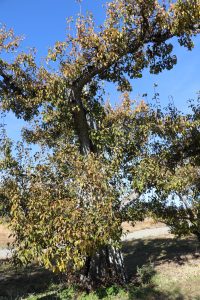Written by Tianna DuPont, WSU Extension. October 29, 2021.
Facing rising input and labor costs, optimizing production is essential to the pear production bottom line. Growers are familiar with the horticulture basics essential for productive orchards, but we all have a block that we are not happy with the vigor, balance, or fruit set. The goal of WSU Extension’s October study circle was to discuss factors contributing to success as well as blocks with challenges in order to share ideas and help each-other find solutions. We discussed tree architecture, pruning, nitrogen and micronutrient applications, irrigation, and pollination with grower panelists Dave Burnett, Kramer Christensen, Sam Parker, Blaine Smith, Darin Palmer, and Stefano Musacchi, WSU Endowed Chair of Tree Fruit Horticulture.
Tree architecture
Growers Christensen, Burnett, Parker, and Smith all agreed that their higher density modern plantings have more consistent high productivity and quality. One participant described one of his younger blocks planted on OHxF.97 and trained with four leaders which is performing at 55-60 bins per acre. Not only is production on target, but it requires fewer inputs than older blocks on wider spacings he said. “If I could do every orchard higher density, I would,” said Burnett. One of the blocks Burnett is happy with is a 11 by 10-foot d’Anjou block on OHxF.97 rootstock with an interplanting of 7th leaf Bartletts. The higher density blocks have better spray coverage and pickers want to pick them, Burnett said. Smith has also recently planted a high density block he is really pleased with. The block is Bartlett on a 2 by 12-foot spacing. “Higher density is a really efficient way to grow,” said Smith. Musacchi shared his experience with a high density pear planting in Entiat. The block was planted to a Bi-Axis on OHxF.97 rootstock at a 12 by X 5 foot spacing in 2017 (2.5 feet between each axis) (A pathway for pears. https://www.goodfruit.com/a-pathway-for-pears/). The current production of fifth leaf trees is approximately 50 bins per acre. “Narrow canopies like this 2-dimensional system will be required for mechanization in the future,” Musacchi emphasized. About the sustainable orchard design and management for the future, recently Musacchi published a review entitled: Training Systems and Sustainable Orchard Management for European Pear (Pyrus communis L.) in the Mediterranean Area: A Review (Musacchi S, Iglesias I. and Neri D., 2021). This is an open-access publication available for everybody.
Light management
“Light is THE key factor,” Burnett told us. In order to favor productive wood in the tree, Burnett opens up windows in the canopy. To bring more light to the lower and middle parts of the canopy, Burnett opens up the middles and brings down the height favoring small branches (thumb and pencil sized) that will be good fruiting wood. This effective light management is essential for bud set. “Below 30% of light availability, you get no bud set,” explained Musacchi. Buds are initiated in the late spring of the year before they produce fruit. In June, the amount of light each bud is exposed to significantly influences if that bud becomes a fruit or shoot. In many older canopies, the bottom part of the canopy does not have enough light penetrating the canopy to form fruiting buds. For example, a recent study was done by the Musacchi’s program (Zhang J., Serra S., Leisso R.S., and Musacchi S., 2016. Effect of light microclimate on the quality of ‘d’Anjou’pears in mature open-centre tree architecture. Biosystems Engineering, 141: 1-11) showed the reduction of light penetration in the internal zone of the 3D canopy tree and the dramatic effect of fruit quality. Effective pruning is essential for sufficient light exposure throughout the canopy. A leaf that is below another leaf only receives 10% of the light that hit the leaf above, Musacchi explained. In excessively vigorous and shady blocks Parker explained that he slowly works on opening up the canopy by taking out one large, shade-causing branch every year. He favors pencil diameter wood that is at a flat 90-degree plane to have good fruiting wood.

Pollination
Pear fruit set is mainly dependent on pollination. Well pollinated pears produce not only more but larger fruit. In our traditional d’Anjou-Bartlett blocks, effective pollination can be a challenge. New research by Musacchi’s program has shown that only 50% of the pollen from Bartlett is compatible for pollination with d’Anjou (see Musacchi and Sheick, Fruit set and S-alleles in pear https://treefruit.wsu.edu/article/fruit-set-and-s-alleles-in-pear/). With a low percentage of compatibility, it is essential to increase the number of pollinizers and diversify pollen sources.
Growers felt that optimizing pollination has been essential in productive blocks. For example, Burnett interplanted one of his d’Anjou blocks with Bartletts now in seventh leaf (Figure 2). Burnett told us that adding additional Bartletts to the block improved pollination and increased yields by 5-7 bins per acre. In another block, Burnett flew on pollen this year. “At only $103 per acre, there is nothing else I can do for the kind of return on investment I saw,” Burnett told us. For example this year the block yielded 49 bin/A and last year it was 23 bin/A. Standard recommendations for pollinizers in pears are one pollinizer every third tree in every third row with two hives per acre of bees (Mitcham and Elkins 2007), but growers reported that their blocks with a 1:1 or 1:2 ratio or d’Anjou to Bartlett or Bartlett/Concord are often more productive.

Irrigation
Growers identified irrigation as a factor contributing to a good balance in a block. Smith described his recent experience using irrigation technology to improve fruit quality. In one of their blocks, Smith had challenges with cork. He had been told that we generally watered too much in the spring and wanted to see if this was the case. He invested in irrigation sensors that provide soil moisture information at multiple depths to an application on his phone. We “started to make decisions based on information,” Smith told us. Based on irrigation sensor information, he saw that often when the grass was looking dry, the soil was only dry in the top four inches. Deeper layers were still moist. Smith moderated his irrigation applications skipping early season irrigations when the soil was still wet from winter moisture and moving to more frequent shorter sets in sandy parts of the orchard. “The irrigation sensor investment paid for itself in just one year,” Smith explained. Burnett also noted the importance of irrigation, explaining that one of their challenging blocks has older impact sprinklers, limiting his ability to get across the block quickly. In a challenging block, Parker noticed that sprinklers were widely spaced with insufficient overlap. He replaced the sprinkler heads with a more appropriate size and improved sprinkler overlap. An upcoming study circle on November 30 will focus on irrigation https://treefruit.wsu.edu/event/pear-horticulture-study-circle-2/.
Vigor
Facilitator Tory Schmidt, Washington Tree Fruit Research Commission asked participants, “How much annual shoot growth should we see in mature Anjou trees with a moderate crop load?” One participant said 2-4 ft. Another said, “Two to four feet is way too much.” 1.5-3 feet were more common targets suggested by the group. In order to achieve this balanced vigor, participants discussed pruning strategies, irrigation and nitrogen management.
A key management technique for balanced vigor is pruning. “What I try to do with mature d’Anjou trees is pick where I want the growth,” said participant Steve Hunt. “We prune to encourage growth in certain parts of the tree. I am always looking for growth in the bottom of the tree, trying to limit growth in the tops of the tree…The most important horticultural thing we do every year is prune.” Musacchi described how growers could use fall pruning to reduce vigor. Winter pruning brings vigor to the tree by removing vegetative buds such that each remaining bud receives more of the tree’s energy reserves. “If you have excess vigor in d’Anjou, consider pruning in the fall,” Musacchi said. Taking out one large branch in the fall rather than the winter removes leaves that send nitrogen down to the roots. A recent study in the Musacchi program also showed a positive impact on average predicted dry fruit matter from fall pruning compared to winter pruning (Goke, Serra et al. 2020).
Participants also noted the importance of moderating irrigation and nitrogen inputs when d’Anjou vigor is excessive. One participant noted that we often start irrigating when the irrigation canals open up in the spring, but spring soils are often still moist and don’t require irrigation. By delaying his first irrigation when soils were already moist, he was able to reduce cork spot in a problem block. Multiple participants noted that in excessively vigorous blocks reducing nitrogen inputs can help balance tree vigor. It is important to remember that nitrogen is important for flower bud formation, and low nitrogen status can limit fruit size as well as how long flower ovules are receptive to fertilization. To achieve sufficient but not excess nitrogen, consider the organic matter level in your soils. On average, for every percent of organic matter in the soil 20 lbs per year of available nitrogen is mineralized.
Steve Hunt asked about the cold-tolerant quinces under evaluation in Oregon and Washington. Musacchi mentions that 3 of them appear interesting, but a longer evaluation period is necessary to seek a conclusion due to the graft-incompatibility that characterizes the union between pear and quince. More information are available on the following web page: Quince comparisons – https://www.goodfruit.com/quince-comparisons/.
Micronutrients
Nutrition is important for pear productivity. Low potassium and nitrogen can reduce fruit size. Boron is critical for flower bud formation (Peterson and Stevens 1994). Musacchi explained that small annual applications of boron are recommended rather than waiting until there is a problem. Boron deficiency symptoms are subtle and can cause small yield reductions for multiple years before they become noticeable. WSU recommends 0.5 lbs of actual boron per acre applied as a foliar at prepink or postharvest timing plus a surface broadcast soil application every three ye

ars or when soil tests are below 0.5 mg/kg. Postharvest boron applications need to be in September when leaves are still green “to build up good flower bud formation,” Musacchi explained. For more information, see Crop Protection Guide Nutrient Applications https://cpg.treefruit.wsu.edu/ and Boron Nutrition in Deciduous Tree Fruit Orchards.
Pest control contribution to block health
Psylla pressure, fire blight, and the canker pathogen Valsa impact block health and productivity participants noted. “Has anyone experienced a reduction in fruit set or bud development due to pear psylla?” asked one participant. One participant noted that five years ago, they saw a lot of bud die-off resulting from psylla honeydew. Musacchi agreed that ‘there can be a negative effect on the flower from the honeydew.” This negative impact can be most problematic during flower induction during June.
Musacchi pointed out another often ignored problem: Valsa. Valsa is caused by the fungus Valsa certospoerma (an

omorph Cytospora sacculus) which causes localized necrosis and dieback of limbs and trunks. It can go un-noticed because it is hard to see unless you scrape back the bark of the tree where you see dark brown instead of green tissue, which can be confused with winter injury. Valsa dieback is generally slow as cankers expand and girdle branches or trunks. For this reason, it is important to limit wounding where infections enter and wet conditions which favor infections, especially in young trees. Control measures for Valsa canker include the removal and destruction of infected limbs. Brush piles containing infected material are a potential source of inoculum. Controls have also included canker excision and treatment of wounds with fungicides to reduce canker expansion, initiation, or both. FRAC 1 (Topsin) and 11 (Flint) are fungicides with known efficacy on this type of pathogen. Targeting the lower part of the canopy/trunk is important as there will be a limited entrance into the wood. These fungicides may help limit the spread of the pathogen. Potassium nutrition can be important, make sure K applications are sufficient. Copper fungicides may have some marginal effect by reducing the formation and spread of fruiting bodies (Proffer 2013).
Conclusions
Productivity in pear orchards is influenced by many factors. If you have a challenging block, we hope that hints from this recent discussion with pear growers might give you another idea to improve your block.
Resources
Boron Nutrition in Deciduous Tree Fruit Orchards. Peryea, F. 2018 https://treefruit.wsu.edu/boron/
Crop Protection Guide Nutrient Applications https://cpg.treefruit.wsu.edu/
Musacchi, S., Beers, E., Mattheis, J. 2016. Fall and Summer Pruning to Control Vigor and Psylla in Anjou Pear. Washington Tree Fruit Research Commission Report. PR14-104 https://treefruitresearch.org/report/fall-and-summer-pruning-to-control-vigor-and-psylla-in-anjou-pear/
Honey Bees https://treefruit.wsu.edu/orchard-management/pollination/honey-bees/
Pollination and Protecting Pollinators Video https://treefruit.wsu.edu/article/pollination-and-protecting-pollinators-video/
Pear Pruning and Horticulture in Higher Density Systems https://treefruit.wsu.edu/article/pear-pruning-and-horticulture-in-higher-density-systems-demonstration/
Pear Pruning for Young Bartletts https://treefruit.wsu.edu/article/pear-pruning-for-young-bartlett/
Pruning Bartlett Pears to Optimize Fruit Quality. https://treefruit.wsu.edu/videos/pruning-bartlett-pears-to-optimize-fruit-quality/
Pear Rootstock & High Density Systems Webinar & videos https://treefruit.wsu.edu/videos/pear-rootstock-systems-virtual-field-tour-webinar/
A pathway for pears. https://www.goodfruit.com/a-pathway-for-pears/
Quince comparisons. https://www.goodfruit.com/quince-comparisons/.
References
Goke, A., S. Serra and S. Musacchi (2020). “Manipulation of Fruit Dry Matter via Seasonal Pruning and Its Relationship to d’Anjou Pear Yield and Fruit Quality.” Agronomy-Basel 10(6).
Mitcham, E. J. and R. B. Elkins (2007). Pear Production and Handling Manual. Oakland, CA, University of California Agriculture and Natural Resources.
Peterson, A. B. and R. G. Stevens (1994). Tree Fruit Nutrition shortcourse proceedings. Yakima, WA, Good Fruit Grower.
Proffer, T. J. (2013). Compendium of Apple and Pear Diseases, American Pathological Society.
Zhang J., Serra S., Leisso R.S., and Musacchi S., 2016. Effect of light microclimate on the quality of ‘d’Anjou’pears in mature open-centre tree architecture. Biosystems Engineering, 141: 1-11.
Contacts
WSU Extension Specialist, Tree Fruit
tianna.dupont@wsu.edu
Office: (509) 293-8758
Mobile: (509) 713-5346
stefano.musacchi@wsu.edu

